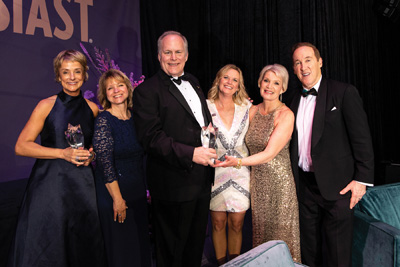Teams are the heart of our workforce, whether a small business or a large one. Wise employers know this and cultivate, train and support their teams to a point of mutual trust and high performance effectiveness. Unfortunately, though, too often work teams are clonedÑformed on the basis of similarities or relationships, with the assumption being that this will result in good teamwork.
This is because the cloned team has the tendency toward "group think" (i.e.,"we all agree that this is a great idea"), thus overlooking other different, and often better, ideas.
Social science research has long maintained that a more diverse team will ultimately be more effective because of its different points of view and personalities. A team with diverse membership has the greater potential to produce a higher quality product precisely because it can break out of the box, capitalize on divergent points of view and offer different perspectives. The process may take longer but is well worth it. We’re talking business strategy here.
Diversity means different things to people. This Readers’ Speak Out! will contribute to our business intelligence on first the issues of race and ethnic diversity on our work teams, and then the more subtle issues of personality differences. We’ll examine how both types of diversity bring value to the workplace.
Certainly diversity initiatives have helped women who in turn have helped their businesses prosper. This is a plus for women who have been too long undervalued, underpaid and underpromoted. Although we still have far to go, it is important to recognize that statistically speaking, affirmative action has most benefited white women.
The other folks in the diversity category who are seeking their place on the team are men and women of color. This is a dramatically increasing population in the US and one that still experiences both subtle and overt consequences of systemic racism. The changing demographics signal a national trend to multiculturalism in the US population. In the country as a whole, it is estimated that students of color will grow to more than 40% by the year 2010.
Decision makers in the business world need to anticipate the next generation of workers. These students will be tomorrow’s workers and tomorrow’s customers, making diversity issues diversity imperatives for the business world. Diversity initiatives no longer stem only from wanting to do the right thing. Today smart companies know that diversity affects the bottom line, enhances the competitive edge, makes for a rich and vibrant organizational culture, and connects the workplace to the marketplace.
The highest proportion of minority hires other than the agricultural industry exists in the high tech world. Jane Rogan, Director of Communications at Westwave Communications in Santa Rosa, says, "It’s not about the importance of diversity—it’s about the fact of diversity. In our field, diversity just is. We hire from all over the world.
According to US Census Bureau 1999 estimates, Sonoma County has 93,711 people of color (21.3 percent). What potential does this represent for Sonoma County business? This is the local talent pool that Sonoma County needs to look to and address training needs for the new economy. To do this we need to create diversity inclusive organizations."
A diversity inclusive organization welcomes fresh energy and revitalization, the richness of talent, perspective, skills, intelligence, creativity, ability and perspective that come together when we form diversity inclusive teams. These teams will help your business maintain competitive advantage, identify market possibilities, and offer new products and services. They provide a catalyst for innovation and excellence.
A diversity inclusive organization understands that a culture change is necessary to address multicultural changes. That multicultural does not mean attempt at a "melting pot." That multicultural does not mean assimilation. That cultural differences are precisely what will make a rich, new environment. And to enter into a multicultural future also requires us to make visible what is white culture and white privilege. This is some of the work that needs to be done.
Other aspects of diversity include those normal personality differences that make life and work interesting and often challenging. Social science points to various models that identify normal, healthy personality type differences. I find particularly useful the Jungian model which looks at 16 different personality types based on preferences in 4 dichotomies: extraversion vs. introversion, sensing vs. intuition, thinking vs. feeling and judging vs. perceiving.
Worthy of a column to itself, suffice it to say here that knowledge about these personality type differences informs us about the various ways team members work together. For example, take communication patterns. Some team members need to talk their ideas out on the spot while others prefer time to think it out first and talk later, or not talk at all (extraversion vs. introversion). Team members look at data differently; some focus on the details and need to know everything before starting a project while others focus on the big picture and have an attitude more like, "don’t confuse me with the details" (sensing vs. intuition).
When it comes to decision-making styles, some team members use human values and subjective criteria while others base their decisions solely on cause and effect and the bottom line (thinking vs. feeling). And finally, members of the team may have different organization styles. You’re going crazy because your team plan is due and you’ve been working in a methodical, structured way to a series of deadlines while others on your team have a spontaneous and pressure prompted style and habitually meet the final deadline with a last minute rush (judging vs. perceiving).
Once we understand these various ways of working, it can take the sting out of what might otherwise appear as contrary or uncooperative. When we encounter resistance or opposition, it’s very human to draw erroneous conclusions about the other person’s motivation, or intention, or sanity, and make negative attributions. Employees who understand and appreciate the differing personality styles of their teammates are better equipped to work together because they see difference as complementary rather than oppositional. This is the essence of teambuilding.
Teambuilding is the process by which we build the trust necessary to become a quality team. A quality team is one that gets the job done with excellence and in which members feel valued and appreciated. No matter the size of the business, when employers are willing to invest in their people, they increase their people equity.
So, let’s take a good look at all our business teams. Those teams may be our work teams, board teams, or management and leadership teams. Let’s take a good, hard honest look and ask ourselves do we have enough diversity on our teams and are we investing the support and resources needed to build those teams?
Don’t we have work to do?"



